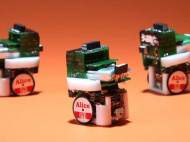Experiments with tiny evolving robots demonstrate why we share
 Altruism, the sacrificing of individual gains for the greater good, appears at first glance to go against the notion of “survival of the fittest”. But altruistic gene expression is found in nature and is passed on from one generation to the next. An evolutionary robotics experiment at EPFL and UNIL supports Hamilton’s rule of altruism and improves swarm robotics collaboration as a result.
Altruism, the sacrificing of individual gains for the greater good, appears at first glance to go against the notion of “survival of the fittest”. But altruistic gene expression is found in nature and is passed on from one generation to the next. An evolutionary robotics experiment at EPFL and UNIL supports Hamilton’s rule of altruism and improves swarm robotics collaboration as a result.
Dario Floreano, head of EPFL’s Laboratory of Intelligent Systems, teamed up with University of Lausanne biologist Laurent Keller to weigh in on the oft-debated question of the evolution of altruism genes. Although it’s hard to test the evolution of altruism using quantitative studies in live organisms, Floreano’s robots evolve rapidly using simulated gene and genome functions and allow scientists to measure the costs and benefits associated with the trait.
“We have shown that Hamilton’s kin selection theory always accurately predicts the relationship between the evolution of altruism and the relatedness of individuals in a species”, said Markus Waibel, lead author of the paper and former doctoral student of both Keller and Floreano.
Previous experiments by Waibel, Floreano and Keller showed that foraging robots doing simple tasks, such as pushing seed-like objects across the floor to a destination, evolve over multiple generations. Those robots not able to push the seeds to the correct location are selected out and cannot pass on their code. Robots that perform comparatively better see their code reproduced, mutated, and recombined with that of other robots into the next generation – a minimal model of natural selection. After hundreds of generations, these robots become more efficient and even learn to work in groups without any further interference from the researchers.
In their new experiment, the researchers enabled a foraging robot to decide whether it wants to share the pushed seed after it is pushed to the proper destination. Evolutionary experiments lasting 500 generations were repeated for several scenarios of altruistic interaction (with different values of how much is shared and to what cost for the individual) and of genetic relatedness in the population. The researchers created groups of relatedness that, in the robot world, would be the equivalent of complete clones, siblings, cousins and non-relatives. The groups that shared along the lines of Hamilton’s rule foraged better and passed their code onto the next generation.
“We have been able to take this experiment and extract an algorithm that we can use to evolve cooperation in any type of robot”, said Floreano. “We are using this altruism algorithm to improve the control system of our flying robots and we see that it allows them to effectively collaborate and fly in swarm formation more successfully.”
For more information, you can read the article published in the PLoS Biology named: “A Quantitative Test of Hamilton’s Rule for the Evolution of Altruism”.









Leave your response!